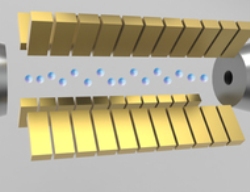Aug 14 2013
Research groups at Johannes Gutenberg University Mainz (JGU) and the Physical-Technical Federal Institute (PTB) in Braunschweig, working in collaboration with scientists at the University of Ulm and The Hebrew University of Jerusalem, have been investigating the formation of defects occurring when a Coulomb crystal of ions is driven through a second-order phase transition.
 Diagram of the ion trap employed. The ions are held in place by the electrical fields between the gold-plated electrodes. The image of the ionic crystal with defect has been massively enlarged.
Diagram of the ion trap employed. The ions are held in place by the electrical fields between the gold-plated electrodes. The image of the ionic crystal with defect has been massively enlarged.
For this purpose, they compressed one-dimensional linear chains of ions at high speeds to form a two-dimensional zigzag structure with a form similar to that of an accordion. This process can lead to the generation of defects in the resultant crystal structure. The probability of such defects forming is determined by the speed of the phase transition. The Kibble-Zurek mechanism, which describes the formation of such defects, is universal as it plays an important role in many physical systems. Among other things, this mechanism is the basis of one theory of how matter was created 10-30 seconds after the Big Bang. The experiments undertaken in Mainz investigated and analyzed this effect with a hitherto unrivalled precision.
The Mainz research team from the Quantum, Atomic, and Neutron Physics (QUANTUM) work group of the Institute of Physics at Mainz University trapped 16 ions in a Paul trap. In this form of trap, ions are confined to a very small space with the aid of electric fields where they arrange themselves in a sequence like pearls in a necklace. The next step is to drastically reduce the space in which the ions are confined so that the ion chain is compressed and becomes folded to form a zigzag structure. However, the ions can assume a particular zigzag pattern or its mirror-inverted version. If one half of the ion chain takes on a different structure to that of the other half of the ion chain, the two patterns that are the opposite of each other will meet in the middle. Since the two different patterns cannot join perfectly, there will be a defect in the crystal structure right at this point.
Due to the form of the trapping potential, the phase transition first occurs in the center of the ion chain and is then transmitted from the center to the ends of the crystal. If the rate of this transmission is faster than the speed of the exchange of information between two neighboring ions, one of these ions will not be able to orientate itself on the basis of its neighbor's structure and will arrange itself randomly. This is why the probability of such defects occurring is significantly determined by the rate at which the phase transition occurs. The speed can be precisely controlled and varied in ion traps, which allowed the Mainz and Braunschweig researchers to determine the rate at which defects occurred relative to phase transition speed. The experimental findings confirm the hypothetical assumptions on which the Kibble-Zurek mechanism is based at a 2 percent level of significance.